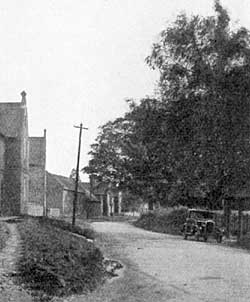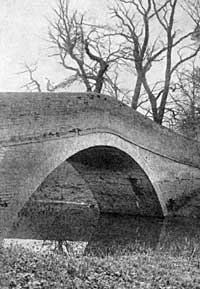Nottinghamshire Villages: Stanford-on-Soar
By Alfred Parker

Little STANFORD-ON-SOAR is our most southerly village, and though some 48½ miles divide it from Finningley in the north, the road journey will register somewhere in the vicinity of 60 miles on our speedometer before (turning right from the Nottingham-Loughborough main road at Rempstone and turning left soon after we pass Stanford Hall), we drop into this model village.
There are other approaches to Stanford, all of them possessing some charm, for the needs of motor traffic have not denuded the hedgerows of their trees or swept away the grass verges which are one of the best features of our older country ways.
The sunken road leading into the village from the Normanton side has something in common with the fern-gowned lanes of Devonshire and, when the sun bakes down on a summer's day, makes an inviting little stretch in which to linger.
From the Leicestershire side one may keep the right bank of the Soar or, crossing the meadows, come up to Stanford over the river and under the railway. From this south side, the church once stood up on its slight eminence, a prominent landmark indicating the early ford and later bridge over the winding stream. But such is the effect of transport developments, the high embankment of the "Great Central" Railway (the L. & N.E.) not only masks this once charming scene but has almost divorced the village and the water from which it derived its ancient title. The old course of the Soar is still clearly defined on the church side of the railway, though the main stream has been diverted and runs on the opposite side of the embankment.
A rather charming relic of the diverted roadway remains in the narrow, hump-backed bridge of warm, red brick which now carries only a little frequented footpath, passing an isolated cottage at the bridge foot. From the crown one looks over a patch of weed-congested water, fringed by tangled undergrowth, having an eventual outlet through an insignificant culvert. Sad change for a once sparkling stream wherein the Lords of Stanford Hall held much-valued fishing rights.
This right is specifically referred to in the grant of the manor and advowson of the Rectory made to Robert Raynes, the Queen's Goldsmith, in the time of Philip and Mary, 1558. It enumerates "the whole demesne and Manor of Stanford, 11 messuages, 14 cottages, 1 horse mill, 50 acres land, 100 of meadow, 300 of pasture, 3 of wood, 1,000 of furz and heath with all their appurtenances in Stanford, the whole of the fishing and liberty of fishing in the waters of the Sore at a yearly rate of 6s. 1d. and yearly rent of 15s. issuing out of the hands of — Barlow, Esq., of Boney, which were lately parcel of the possession of Thos. Knifton, Gent., attaint of High Treason and the advowson and patronage of the Rectory and Church of Stanford."
Those five years of Mary's reign were indeed troublous ones—plots and counterplots constantly simmering— and apparently little was needed to bring a man under the dread charge of high treason, with its usual forfeiture of life and lands.
Much earlier than this, Stanford had changed hands as a Monarch's gift to a favourite, when, soon after the Conquest, the Norman William granted it to his powerful supporter, Roger de Busli, who held nearly 200 manors in the Shire. Prior to this one Elsi had the manor, and for it paid Danegeld (the tax first levied for the purpose of buying off the Danish marauders in the time of Ethelred the Unready).
It is interesting to reflect that the population of Stanford has certainly not grown to any great extent since those early days—Bush's portion held 5 Sochmen or Freeholders, 3 Villanes or Husbandmen and 2 Bordars or Cottagers, while Robert FitzWilliam, who appears to have held other part, controlled 4 Sochmen, 7 Villanes and 2 Bordars, and seems to have shared rights of the mill, for Busli had but "half a mill."
This right of holding a mill was a very important one, for all who had corn to grind must bring it to the manorial mill and thus the dues which depended in any way upon the harvest might be more certainly checked, while the charges for milling, whether paid in kind or otherwise, served to swell the coffers of the overlord.
We have seen that this right was of some consequence in the time of the Tudors, but the horse mills of that day may have superseded a water-driven mill, though there is not any very great fall in the river to-day. Horse mills, with their endless stair, were fairly common at one time and we find mention of them in Nottingham and elsewhere, though wind and water power were more generally utilized.

We can only presume that the early mill and manor stood in close proximity to the village, in the field still known as the Hall Field, standing near the bend of the river as it swings beneath the railway arches.
In any case, the situation did not appeal to the Goldsmith's grandson and namesake, Robert Raynes, who held possession in King Charles the First's time and who is described as "a thrifty man," for he decided to move to higher ground, building his house "on the top of a barren hill" whither he intended to remove the town also. The latter part of his programme he did not live to carry out and his son, who probably too eagerly plunged into the gaieties of the Restoration, was compelled to sell his estate to an Alderman of London, Thomas Lewes, destined later to become High Sheriff of the County.
Though the site of the "town" was not moved, it was at a later date virtually replaced so far as the buildings are concerned, and this reconstruction accounts for the "atmosphere" of the village as we see it to-day—somewhat aloof in its livery of nineteenth century "Tudor" brickwork.
The gable ends of the fine farm buildings bear the monogram of the man who brought about this change, R.H.R. (Mr. Richard Ratcliff) and the date 1889.
The village pump beneath its tiled shelter displays the same initials and the date 1902 (the year of King Edward's coronation). This and the Lych Gate further along the road give to the lane a sense of charm.
The Lych Gate itself, though modern, is worthy of a few minutes study, and through its oaken timbers is to be obtained one of the most charming views of the church, clustered with stately elms, its churchyard set with sombre yews.
